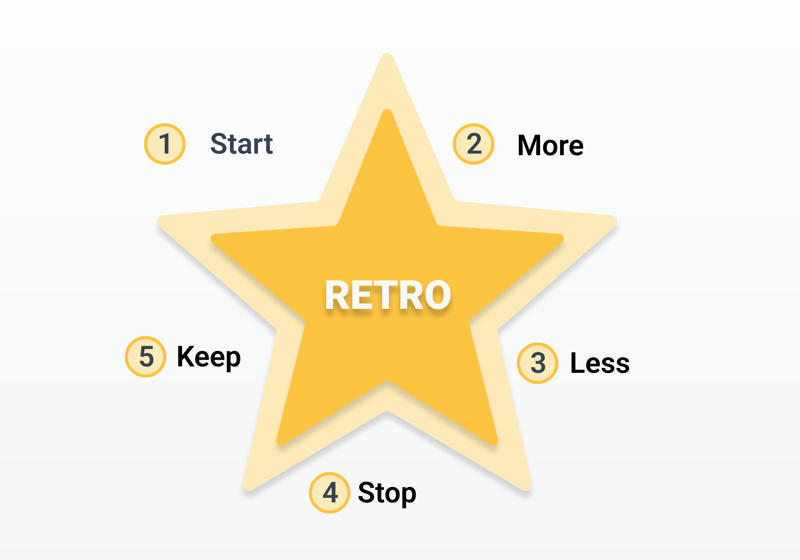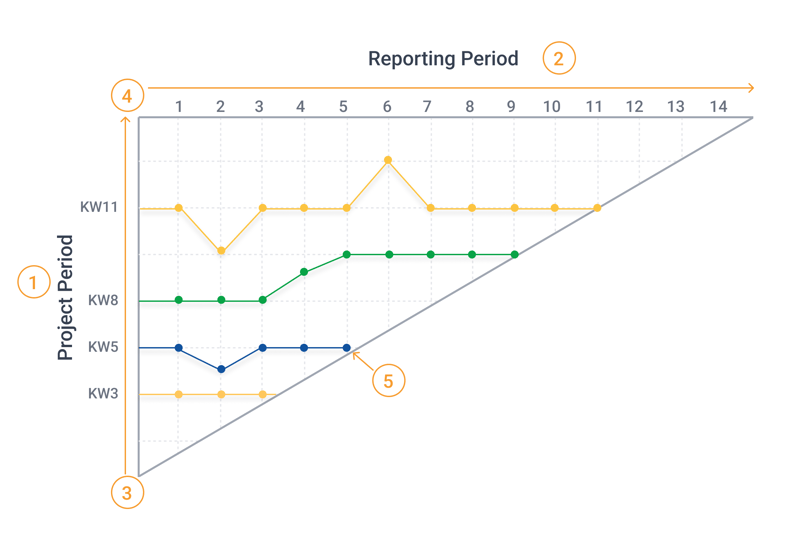Multi-Project Management: Definition, Strategies, and Success Factors
When you manage multiple projects it's a bit like a non-stop juggling act: Not only do you need to attend to one project's needs and challenges, but anticipate and react to those of several others. To ensure that all goals are achieved, you'll need to choose the right strategy.
In this guide, we'll let you know all about multi-project management, its challenges, and how to use it in practice.
What Is Multi-Project Management?
When too many projects simultaneously compete for a limited amount of resources, chaos, and stoppages are the most common results. Targets and deadlines can be forgotten or missed as it becomes more difficult to maintain an overview. With multi-project management, you can regain perspective and stay on top of each project's needs and requirements.
Multi-project management refers to the coordinated planning, direction, and monitoring of multiple, parallel projects within a department, an organization, or a business.
Differentiation
As a concept, "multi-project management" is often used interchangeably with "project portfolio management" and "program management". However, in technical terms, this isn't accurate or correct.
Multi-project management vs. Program management
Program management encompasses all projects within a business that share a common goal: Fulfillment of the corporate vision.
With multi-project management, on the other hand, individual projects aren't necessarily directed toward a shared goal or part of the corporate program. In fact, they can be completely independent of one another.
Here's a small example to illustrate the difference:
Project management method | Example |
|---|---|
Program management |
|
Multi-project management |
|
Multi-project management vs. Project portfolio management
It's more difficult to differentiate between multi-project management and project portfolio management. The German Institute of Standards (DIN), even lists project portfolio and program management as types of multi-project management.
When you compare descriptions and tasks found in project portfolio management and multi-project management, they're very similar. This means that, unlike program management, multi-project management and project portfolio management can be used interchangeably.
In practice, however, there's at least one important difference: Project portfolio management occurs at the corporate level, whereas multi-project management can additionally be at the department or section levels.
Multi-Project Management Tasks
Multi-project management is all about the direction and management of multiple, unrelated projects.
Special skills and strategies, as well as a solid grasp of project management methods, are necessary to set up such a system. The multi-project manager or project management office (PMO) should expect the following responsibilities:
Cross-project planning
Resource management
Meeting and milestone planning
Ensure transparency and cross-project communication
Risk management
Change management
A multi-project management team must ensure that resources are optimally utilized and allocated and that projects can proceed smoothly. Often, project leaders will need to coordinate between different departments, set priorities, and broker compromises. As the level of complexity increases, it becomes necessary to systematically direct all projects. This serves to reduce risk and identify conflicts early.
Multi-Project Management Orientation
Multi-project management is a constant balance between two types of decisions or interests: Operative and strategic. Project leaders should be mindful that the two often offer competing views on the best way forward.
Operative Multi-Project Management
Operative multi-project management seeks to actively coordinate individual projects. The focus here is on the efficient allocation of resources, the establishment and maintenance of communication between teams, and the monitoring of each project's progress.
Solutions are sought for current tasks and problems that arise within projects.
Strategic Multi-Project Management
Strategic multi-project management looks at the big picture and long-term developments. Decisions are reached and measures planned that help further corporate goals and objectives (irrespective of existing programs).
Project managers must ensure that the right projects are selected, priorities are defined, and project portfolio strategies are continuously adjusted to reflect shifts in business conditions.
Benefits and Challenges of Multi-Project Management
In practice, multi-project management offers many advantages, however, is not without challenges. Next, we'll take a closer look at both.
Advantages
Reduced risk
There is less risk of project failure due to the comprehensive and holistic overview managers have of bundled projects. Mistakes and errors are also not as common.Improved resource planning
Available resources can be more effectively used and allocated.Fewer dependencies
Dependencies between projects can be identified and done away with.
Work more efficiently
Since you'll centrally control projects, they can develop more efficiently and quickly.Project leader support
Project planning and execution can be supported through an experienced project leader or project management office (PMO).More transparency and better communication
Multi-project management increases transparency and communication among teams and between projects.Strategic planning
This approach aids a business or organization in its strategic planning.
Challenges
Multi-layered management
Complex structures that include a large number of projects are difficult to manage and require considerable organizational skills.Complex dependencies
Project dependencies must always be kept in mind. These can influence the prioritization of projects.Time-intensive
Ensuring smooth coordination and communication between multiple teams and departments consumes a significant amount of time.Resource conflicts
Since resources are limited and need to be allocated effectively across multiple teams and projects, competition and even conflict over them is common.Change management is important
Adjustments within a single project can have undesirable effects on other projects. To avoid this, a change management process must be implemented. In addition, there must be knowledge management to ensure that experience is exchanged between teams.Team conflict
As noted above, project teams will compete and even come into conflict with one another.
Multi-Project Management in Practice
In 2021, the Project Management Institute (PMI) revealed that across Europe, 40% of projects fail. Of those that are completed, half are finished on time, but only 57% are within their budget.
Why is this? The truth is that there isn't a single answer. Many different factors can influence a project's direction and progress.
It's important to use a proven strategy to avoid the pitfalls and minimize risk. Strategies provide optimal conditions and a framework that you can use to ensure that your projects remain viable and efficient.
Strategies and Tips for Successful Multi-Project Management
Below, we've summarized several tips and strategies.
Project Prioritization and Selection
Used fixed criteria to prioritize and select projects. Evaluate their usefulness, resource requirements, and potential risks.
Pay close attention to the number of parallel projects, as shown in the example below:
In 2013, an Indian pharmaceutical company paused 30% of planned projects. The result? Within 12 weeks, the company successfully completed 83% more projects than it had over the previous three-month period. This shows that it's beneficial to determine what your organization's optimal number of projects is.
Resource Management
Effective resource management is crucial to project success and can help identify conflict situations early before they cause serious problems.
The main focus is on the efficient allocation of available resources in relation to the number and complexity of projects.
Use a resource planning and management tool to better distribute and coordinate staff and material. Resource allocation should follow clear and fixed guidelines so that it can also be understood by external observers or stakeholders. This promotes transparency, which can minimize resource competition and conflicts.
Communication and Teamwork
Continuous monitoring, evaluation, and reporting are key elements of successful multi-project management. How best to ensure these? Through regular and open communication, both within the project, as well as with its managers and stakeholders.
Regular reviews, project meetings, status reports, and a retrospective all encourage teamwork. In addition, project processes and responsibilities should always be transparent.
Motivation is also essential: This doesn't just improve employee well-being, but also, productivity.

A retrospective can improve teamwork and efficiency.
Project Start Date
Now that you know your goal or objective, you can get to work. Not quite: Set aside some time to prepare the project and its schedule its start date. If this isn't done, you run the risk of not all team members being on board or available. Of course, they can join later, but this costs both time and resources.
Just like the famous saying "measure twice, cut once", carefully plan your project's launch to ensure that it develops as smoothly and efficiently as possible.
Risk Management
Unexpected risks can arise in any project. To not lose focus, you'll want to develop a structured process for risk evaluation and resolution.
This requires more than just a one-and-done analysis though. Instead, you'll want to create a system that can be regularly assessed, adjusted, and adapted to overcome any risks you might encounter. Keep dependencies in mind, since these have a tendency to morph into risk factors.
Milestones and Deadlines
Projects need deadlines, and milestones keep participants on schedule. Deadlines and milestones must be realistic and clearly reflect the project's progress. Carefully evaluate all components in advance and adapt them to the project's goals.
You should also keep Parkison's law in mind. Although applied to bureaucracy, it can be generalized as "The demand upon a resource tends to expand to match the supply of the resource." In other words, whatever is available will be used to the fullest extent possible.
For a project deadline, this means that the more time that's given to complete a particular task, the longer the team will take to do so. Usually, this means that they'll only start work near the deadline, instead of allocating small amounts of time over a longer period. Try to find a compromise that doesn't create too much pressure, but isn't overly lenient.
Project Portfolio Management Methods
You don't need to reinvent the wheel: There are many ways to manage projects. Some popular methods include a milestone trend analysis, a Gantt chart, or a SWOT analysis. Any of these help to get your projects on track and to reach successful outcomes.

There are many different ways to manage projects, like milestone trend analysis, shown above.
Agile vs. Traditional Project Management
When you integrate agile methods into project management, flexibility is increased. A Kanban board, for example, helps to more efficiently complete tasks and adjust priorities.
In practice, multi-project management usually oversees both agile and classic projects. Should some teams work with Scrum, this can actually enrich the experience for all involved groups.
Project Management Tools
There are plenty of professional tools and software to help your organization meet deadlines and transparently monitor project progress. These also provide support in resource management and milestone tracking. With some, you can create detailed reports and analysis, for an even better project overview.
Below, you can find EXPERTE.com reviews for some of the most popular project management tools:
Projekt Management Office (PMO)
Implementing a PMO is a good idea, especially for large organizations. This serves as the hub for all project management and supports any involved teams. Since responsibilities are shared by multiple team members, rather than a single person, issues can be resolved more quickly and efficiently.
Transparency
Transparency is perhaps the most decisive aspect of multi-project management. Only when everyone can see and understand what other teams are doing, which assignments they have, and what sort of resources are available, can the approach succeed.
Success Factors in Practice
Here, we've summarized those factors which determine the success of any multi-project management undertaking. You might want to note these as a kind of checklist and compare them to your business or organization's efforts.
Successful multi-project management requires:
Clearly defined goals and milestones for every project
Transparent communication and unimpeded information flows
Visible dependencies
Operative and strategic resource planning
Flexibility and a willingness to adapt
Teamwork and motivation
Regular assessment and adjustment of project goals and priorities
Conclusion
Would you like an overview of all ongoing projects within your business or organization? With multi-project management, you can coordinate, plan, direct, and monitor multiple projects at once. Since different interests, needs, deadlines, and resources are involved, this is a serious and complex undertaking.
However, with the right tools and approach, and if needed, the implementation of a PMO, you can successfully juggle numerous projects at once.
Frequently Asked Questions
Multi-project management is a method used to simultaneously direct and monitor multiple projects at the corporate or departmental levels.
In multi-project management, multiple, independent projects with differing goals are directed. In practice, it's often used interchangeably with project portfolio management. Program management, on the other hand, focuses on programs that work towards a common goal, such as a corporate vision.
Multi-project management is excellent for businesses and departments that work on multiple projects at the same time, especially if resources are limited.
The biggest challenges to multi-project management are awareness of dependencies and risks, the adjustment of priorities, fostering transparency, and allocating limited resources.
Popular multi-project management methods include milestone trend analysis, Gantt charts, SWOT analysis, and agile methods, like a Kanban board.
Some of the most-used multi-project management tools include Jira, Asana, and monday.com. These help with resource management, deadline monitoring, as well as reports and analyses.













